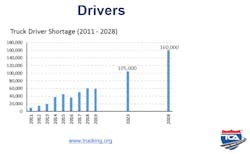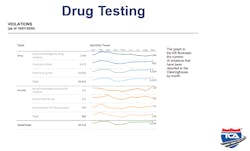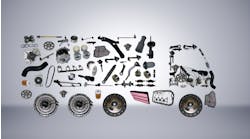Rising insurance rates, failed drug tests and the COVID-19 pandemic are exacerbating trucking’s driver shortage at the start of a decade already expected to put a strain on carrier capacity.
With driving schools graduating fewer new drivers this year and the pandemic-induced recession forcing some fleets out of business, more carriers are rejecting loads than in recent years, David Heller, Truckload Carriers Association’s VP of government affairs, said during a recent virtual conference his organization hosted.
Heller said the current driver shortage stands around 80,000 — a more than 30% increase from 2019. By 2023, the American Trucking Associations project that number to top 100,000 and continue to climb toward 160,000 empty seats by 2028. “I think people are seeing this (problem) in the industry as they look for drivers to haul freight,” Heller said.
In October, carriers rejected one in four loads, which Heller compared to the “great year that everybody had in 2018” when carriers rejected one in eight loads before things cooled off in 2019 when carriers rejected one in 20 loads. “That just shows you what kind of capacity we’re looking at right now in terms of getting freight moving and getting drivers to haul it,” Heller said. “It’s actually tighter than it was in 2018, which is driving driver salaries up as rates go up.”
Getting through COVID and getting more driving schools operating at full capacity — graduation rates are down 30% to 40% since the pandemic began — will go a long way in improving capacity, he said.
Independent contractor rule in limbo
Another aspect that could affect capacity is the U.S. Department of Labor’s proposed independent contractor rule, which relies on an “economic realities test,” Heller said.
The DOL’s proposal would not immediately impact California, which already has strict laws about independent contractors, which went into effect earlier this year. The California law, known as AB-5, does not affect owner-operators or motor carriers thanks to a preliminary injunction granted by the U.S. Southern District Court in January.
Under the DOL proposal, a court must evaluate if a worker is economically dependent on an employer or is in the business for themselves. A court would use two core factors to evaluate the status of a contractor: the nature and degree of control the worker has over the work, and the worker’s opportunity for profit or loss based on initiative and investment, according to Heller. These factors help determine if a worker is economically dependent on someone else’s business or is in business for himself or herself. If both these factors indicate either independent contractor status or employee status, no further inquiry would be needed under the proposed rule.
“Many Americans choose the independent contractor model — including hundreds of thousands of owner-operators in the trucking industry — because it expands their opportunities to earn and empowers them to choose the hours and routes that suit their individual needs and lifestyle,” Chris Spear, president and CEO of ATA, said earlier this year.
“This is an industry that relies and thrives on this business model, which has been around for years,” Heller said. “And this is the first crack at a federal definition that I’ve seen in a long time.”
But its future is in question with a new presidential administration coming in next year.
But if the rulemaking is not finalized by Jan. 20 when Joe Biden is sworn in as the 46th president, it might die before becoming official thanks to Biden’s ties to organized labor, Heller noted. “The Biden administration could also undo this new rulemaking and issue a new rule” if the Trump Administration gets the rule finalized over the next weeks.
Drug testing
Another obstacle for keeping drivers in the industry is the FMCSA’s nascent Drug and Alcohol Clearinghouse. More than 33,000 tests came back positive this year (and nearly 5,500 drivers refused to take a test), as of Oct. 1. “So this continues to be the biggest issue out there — drug testing and the results,” Heller said.
The most significant violation, by far, is for marijuana use, which makes up 52% of the violations. With more states legalizing marijuana in some form, the substance’s appearance in drug tests continues to grow. The next most common violations were for cocaine (14.5%) and methamphetamines (9.5%) and amphetamines (9%).
Since the clearinghouse began in late 2019, Heller said that 37,617 CDL drivers have at least one drug or alcohol violation. “When we talk about drivers leaving the industry — of that almost 38,000 drivers, 26,500 have not started the return-to-duty process,” he said. “So the assumption is they’re actually leaving the industry altogether… We’re a zero-tolerance industry and that’s a good thing for this industry. But not getting the drivers back, on top of the COVID environment and training new drivers, it becomes an even bigger issue.”
An important date for the Clearinghouse is Jan. 5, 2021, which the deadline for all fleets to have run at least one annual drug query of all its drivers. “If not, you’ll be out of compliance,” Heller said. “So make sure you get that done by Jan. 5.”






